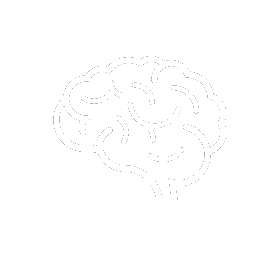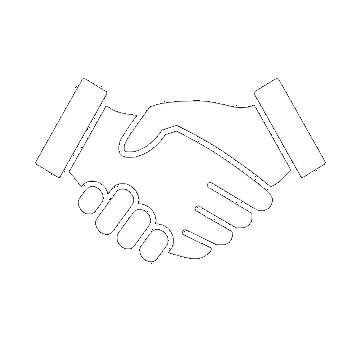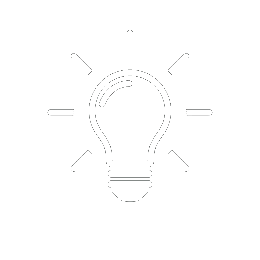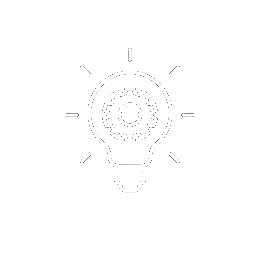TBP: My self-improvement research notes
Here's a compilation of most of my research regarding self-improvement. The purpose of this project is to replace lengthy articles with succinct and exhaustive information while retaining it in a clear, stable framework. Click here or scroll down to learn more.
Disclaimer: This research is by no means exhaustive. As of today, this research relies solely on two books and only several government websites. Other sources, though largely credible and conscientously selected, may possibly be improved.
This framework will be constantly updated and refined to eliminate its weaknesses.
- See also: References
About the project
Purpose
The Big Picture (TBP), started in January 2022, was primarily aimed at increasing life and work quality and effectiveness by providing means of understanding concepts vital for various mental processes, such as creation or communication, and solutions for common self-discipline issues. As such, it was primarily based on analyzing and solving pitfalls effectively. Therefore, the current purpose of TBP is to provide a consolidated framework of information compiled from numerous reliable sources (such as articles, books, or videos) that is composed solely of concrete information, allowing the reader to directly access what they need to know without wasting an unnecessary amount of time, thereby retaining the big picture of the matter (hence the project's name).
This project is not meant to discourage or stop you from doing your own research. Exploration, whether by reading books and publications or by watching or listening, as well as taking your own notes, is just as important for the sake of your own experience. Rather, TBP is meant to act as a replacement for sites which make quick research for a brief point an unnecessarily long read and encourage unproductive descending into what I like to call "do you relate" stories which by no means facilitate quick nor effective, memorable learning. This site is therefore not to be read in one go but visited each time one wants to quickly revise the general, key concepts of a topic.
Structure
Unlike other sections of the website, all of TBP is located collectively on one page. This is because many elements, such as self-discipline and effectiveness, aren't to be found in one place but rather result from the whole picture, as I discovered while doing the research, and as such the facts are interconnected. Similarly, one source can sometimes cover multiple subjects which calls for retaining the references together. For these reasons, I've provided each section with a small table of contents to allow freer movement around the project and to retain the idea of providing a big picture view.
Each of the seven subjects is in H1 while respective sub-subjects in the tables of contents have respective header sizes. Source numbers are located in square brackets in superscript next to the titles they concern. If a title contains subtitles with no source number next to them, it means they all belong to the same source next to a title above. Whenever several sources are cited for one indivisible subtitle, it is clearly emphasized which source was used at which moment in the text.
How credible is TBP?
99% of this page has been created a posteriori, and as such its credibility relies on the sources used. All sources can be found in the References at the end of the page.
While for the most part I've tried to find reliable information, I cannot state in full certainty that TBP is an absolutely dependable project. However, whenever there is time I'll try to replace unprofessional sources with more elaborate ones.
Feel free to add your bit
Undoubtedly, the framework does not include everything a reader who is really into self-improvement would need, nor is perfect. Therefore, contribution to the project is welcome. If you want to add a missing fragment or improve an existing one to strengthen the big picture, feel free to contact me and together we'll see how this can be accomplished.
Health
Disclaimer: This section may be found too general and doesn't cover specific issues.
Contents
- Eye health
- Back/spine health
- Stomach & eating
- Exercise
- Muscle mass
- Blood pressure
- Other body parts health
1. Eye health
Digital eye strain[1][2]
Symptoms
- Red, dry or irritated eyes;
- Blurred vision;
- Eye fatigue;
- Back, neck and shoulder pain;
- Headaches.
Solutions
- Keep a distance from the screen; a monitor should be kept at least 51 cm (1.67 ft) – about an arm's length – away from the eyes (TV – 1.5x size of the screen, smartphones – 41-46 cm (1.35-1.5 ft))([1])
- 20-20-20 rule: Every 20 minutes, take a 20-second break and look at something 20 feet (6 meters) away. (Even short breaks make a huge difference);
- Blink more often (Looking at a screen decreases the number of times you blink, causing eyes to dry);
- Adjust the brightness of your screen;
- Clean your screen;
- Increase text size whenever possible.
Glasses tips[3][improve source?]
Glasses can get dirty due to:
- touching the glasses;
- dust building up overnight;
- long eyelashes rubbing off the lenses.
It's recommended to clean glasses every day. One of the best ways to clean glasses is with lukewarm water and dish soap.
2. Back/spine health
Exercising[4]
Recommended exercises: the curl-up, the side plank, and the bird-dog.
Spend less time sitting[5][6]
Consider sitting less because:
- your body is built for motion;
- sitting reduces blood flow and the amount of oxygen entering your blood stream through your lungs (your brain needs both to remain more alert -> your concentration levels will likely dip);
- you're burning fat less.
When you have no choice but to sit, try switching the slouch for a straighter spine.
Solution[6]: consider using a kneeling chair. This type of chair breaks you out from static positions, relieves pressure on the body, and prevents from sitting still for long periods of time.
("The idea behind the design is that one seat is angled forwards to balance the pelvis, and thus the spine, in a poised natural position with an open hip angle. The knee pads on good kneeling chairs are not used all the time, because the legs adopt various positions, but the shin pads can prevent the body slipping forwards. This ‘kneeling’ position encourages your postural muscles to better align your back, shoulders and neck.")
Put a pillow under your knees when sleeping[7]
Sleeping on your back with a pillow under your knees has many benefits:
- It keeps your back neutral;
- It evenly distributes your weight against the widest part of your body;
- It keeps you from rolling over into less ideal positions.
"Here’s how you can optimally set up with a pillow between your knees.
- Lie down with your knees slightly bent toward your chest.
- Put a firm pillow between your knees so that your upper thigh is elevated enough to keep your hip neutral.
- If you’re using a thin pillow, or if you like to sleep with your top leg slightly in front, you may want to use two pillows.
- If there’s a space between your waist and your mattress, you may want to put another small pillow in the gap to keep your spine from bending."
Stop bending your neck when using a phone[8]
Face-to-phone position gives abt. 27 kg (60 lbs) of pressure on your neck while phone-to-face position gives only 4.5-5.5 kg (10-12 lbs) of pressure.
3. Stomach & eating
Healthy eating[9]
Here's a good summary on healthy eating. You can read more here.
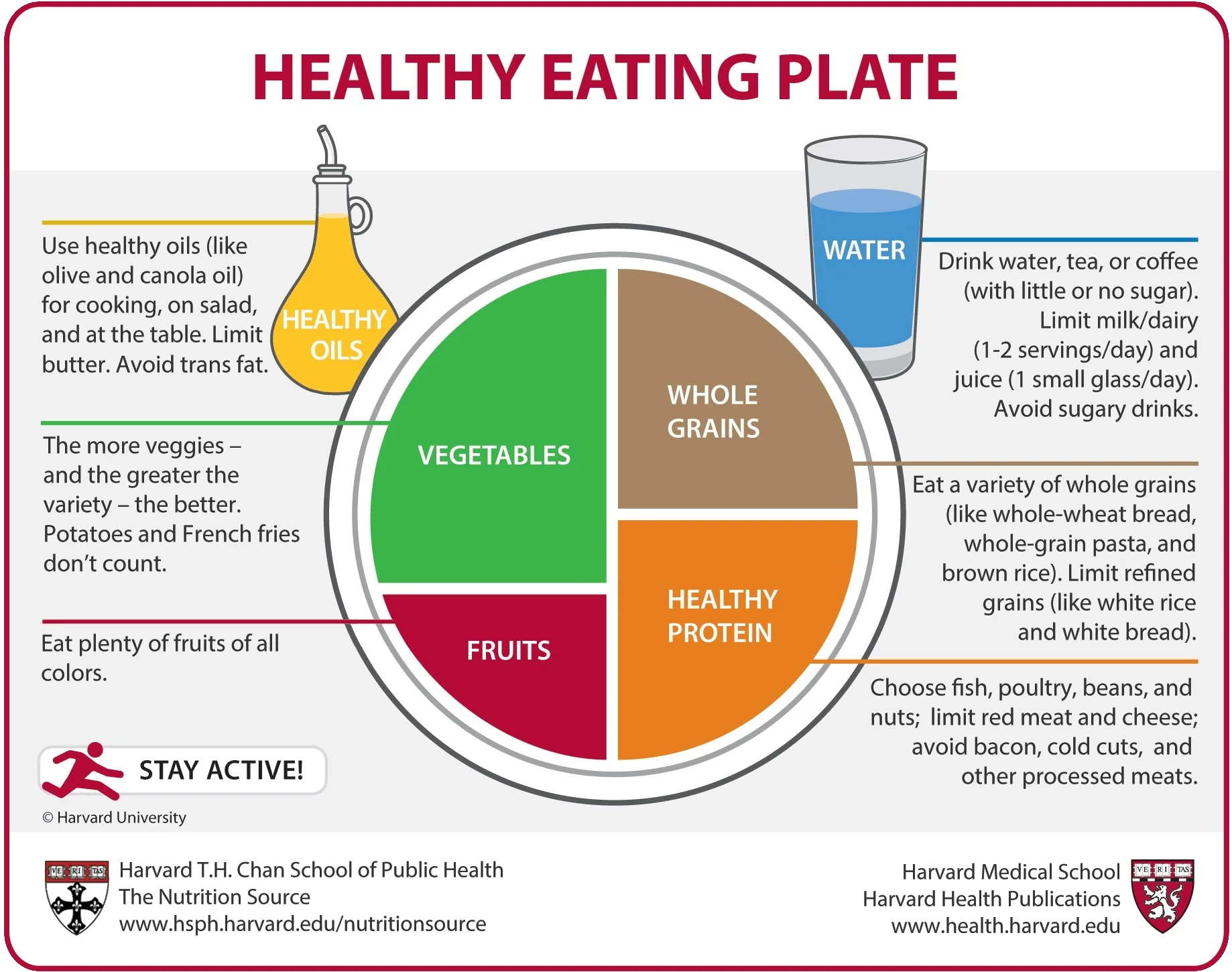
What is unhealthy?[10]
Anything that lacks nutrients, vitamins and minerals, and is high in kilojoules (energy), salts, sugars, and fats.
Unhealthy food includes:
- cakes and biscuits
- fast foods (such as hot chips, burgers and pizzas)
- chocolate and sweets
- processed meat (such as bacon)
- snacks (such as chips)
- sugary drinks (such as sports, energy and soft drinks)
- alcoholic drinks
Is it OK to eat a small amount of junk food?
Generally yes, but keep it small. However, consider minimising it if you're trying to lose weight.
Other tips[8]
Stomachache
Lay on your left side and rub your stomach in clockwise circles.
Eat home-cooked meals
You are 47% more likely to live an extra decade if you eat home-cooked meals five times a week.
4. Exercise
Benefits of exercising[11]
- Improved brain health: strong thinking, learning and judgment skills, reduced risk of depression and anxiety, improved sleep;
- Better weight management (adjusting eating patterns helps just as much);
- Reduced risk of disease, including heart disease, stroke, type 2 diabetes, infectious diseases and several common cancers. Regular physical activity also lowens blood pressure;
- Stronger bones & muscles. This is especially important for older adults who experience reduced muscle mass;
- Improved performance of everyday activities;
- Increased chance of living longer;
- Regular physical activity can help people manage existing chronic conditions and disabilities.
Exercising myths[12]
- Hunter-gatherers weren't all that stronger than us in general
- Running doesn't destroy your knees; it actually causes your joints to repair themselves and stay healthy
- Sacropenia: if you want to maintain your health and stay strong when older, you have to keep exercising. Physical activity when older is more important – not less important – for preserving your health.
Does body type impact exercise?
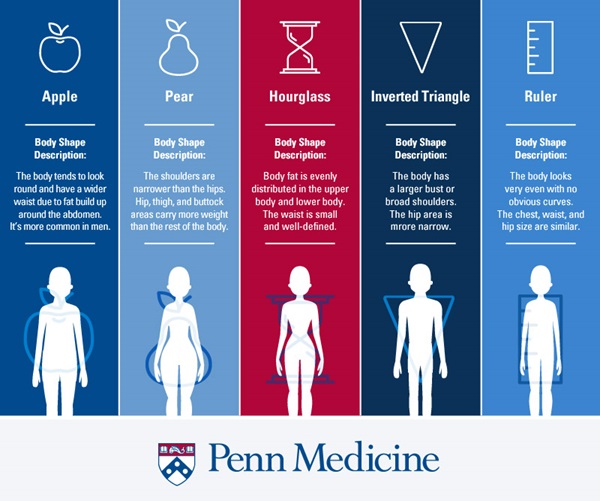
Recommended material: blog post by Penn Medicine
List of exercises
Recommended material: A 4-minute video on major muscle groups by Khan Academy
Click here for a great "exercise dictionary" from strengthlog.
Push-ups
Benefits[13]
Push-ups:
- improve the strength of your triceps, chest and shoulders;
- increase core stability;
- improve shoulder health and function;
- burn fat.
Common mistakes[14]
- Your elbows are flared out. This puts a lot of stress on your rotator cuff, which can lead to injuries. Keep your elbow tucked as close to your body as possible and think of pushing through your armpit.
- Your hips are sagging. This can cause lower back pain. Keep your head, upper back and hips all in a straight line during the entire push-up. (Fix: Tightly squeeze your glutes (butt muscles) during the exercise. Also, consider positioning your feet against a wall.)
- You rely on gravity. Instead of simply dropping to the floor, drive your palms into it and use your arms to pull your body to the ground.
- You’re not stretching your wrists. To find relief, stretch your wrists in between sets. (It happens simply because you don't typically bend them that way.)
- You do incline pushups or knee pushups. To make the leap to full push-ups, consider trying the Bear Crawl Pushup (also called a Bent-Knee Pushup).
Frequency of push-ups (and other exercises)[15]
Make sure you're:
- using perfect technique;
- not training past the point of failure;
- getting adequare sleep and a good diet;
If so, you can do push-ups every day, but consider taking a day off every week anyway.
5. Muscle mass[16]
How to build more muscle mass
- Eat breakfast. Best bets: omelettes, smoothies, cottage cheese.
- Eat every three hours. Try to intersperse breakfast, lunch and dinner with meals post workout, pre-bed and two snacks in between. (Not eating for long periods can cause you to over-eat at the next meal!)
- Eat protein with each meal. 1g per 454g of body weight (200g/day for 91kg). Whole protein source examples:
- Red meat: beef, pork, lamb, etc.
- Poultry: chicken, turkey, duck, etc.
- Fish: tuna, salmon, sardines, mackerel, etc.
- Eggs (including yolk).
- Diary: milk, cheese, cottage cheese, quark, yogurt, etc.
- Whey (not necesary but great for easy post-workout shakes)
- Try vegan options too, such as lentils, tofu, seeds and nuts.
- Eat fruit and vegetables with each meal.
- Eat carbs only after your workout. (rule 4 applies though, they contain few carbs)
- Eat healthy fats. Avoid artificial trans-fats and margarine.
- Drink water. Strengh training causes water loss (through sweating) which can impair muscle recovery.
- Eat whole foods 90% of the time. Examples: fresh meat, fish, poultry, eggs, vegetables, pulses, fruits, rice, oats, quinoa, etc. (On the contary, processed footds usually contain added sugars, trans-fats, nitrates, corn syrup, sodium and more chemicals. Examples: bagels, fruit bars, cereals, pizza, cookies, sausages, frozen meals, supplements.)
6. Blood pressure
Benefits of low blood pressure[17]
Low blood pressure reduces risk of stroke and heart diseases/attacks.
27 percent reduction in total mortality
Dangers of high blood pressure[18]
It can damage your heart, brain, kidneys, and eyes.
- decreases oxygen flow, which can cause:
- stroke, which can cause:
- serious disabilities in speech, movement and other basic activities
- death
- brain problems, such as:
- poorer cognitive function
- dementia
- stroke, which can cause:
- decreases blood flow, which can cause:
- chest pain
- heart attack
- heart failure
- increases risk for chronic kidney disease.
Optimal blood pressure[19]
Upper boundary: for everyone – 120 over 80 (systolic 120 mm Hg and diastolic 80 mm Hg).
Lower boundary: for people who don't naturally have low blood pressure, if you experience dizziness or lightheadedness – 90 over 60[20]; otherwise not big deal[21]. Higher for older people.
How to decrease blood pressure
- get enough regular physical activity (recommended: at least 2 hours and 30 minutes of moderate-intensity exercise, e.g. brisk walking or cycling)
- eat a variety of foods rich in potassium, fiber, and protein
- avoid foods rich in salt (sodium) and saturated fat
- keep yourself at a healthy weight [expand/link]
- do not smoke
- limit alcohol (men: max 2 alcoholic drinks per day, women: max 1)
- get enough sleep[22]
- don't take hot showers[23]
- meditate[24]
7. Other body parts
Ear health[25]
Tips for improving hearing and preventing hearing loss:
- Avoid loud noises: turn volume down on devices and consider using earplugs in excessively loud environments;
- Keep your ears dry: gently dry your ears with a towel after bathing or swimming;
- Don't smoke, as it hampers blood flow and oxygen crucial to maintaining healthy ear cells;
- Prevent excess ear wax, as it can cause mild hearing loss and discomfort;
- Be careful with cotton swabs inside the ear;
- Listen to ambient noises in a quiet environment.
Other things that can improve hearing include:
- B vitamins, magnesium, zinc
- Exercise
- Reducing stress
- Avoiding high blood pressure
Dental and oral health[26]
Things you can do to improve dental and oral health:
- Brush teeth twice a day
- Consider flossing daily
- Do not smoke, use tabacco products, or drink alcohol
- Consider visiting a dentist at least once a year
Hair health[27]
How often should you wash your hair?
Normally it's about 2-3 days, but take these factors into account:
- Age: the older, the less. Teens should shower daily while older adults may only need to shower once a week;
- Hair length: the longer, the drier;
- Hair type: curly hair tends to be drier than straight hair;
- Ethnic background.
Signs you're washing hair too often
- Dry, brittle hair;
- Hair breakage;
- A dry, irritated or itchy scalp.
Other tips
- Protect your hair from chlorine[28]: Chlorine causes hair and skin to be dry, rough, and damaged. There are several ways to prevent this: you may wet your hair first, wear a swim cap, use a conditioner or apply oil;
- When applying shampoo, pay the most attention to the scalp. Also, avoid too hot water when showering[29];
- Don't apply hair conditioner to your scalp[30].
Skin health tips[31]
- Protect yourself from the sun
- Don't smoke
- Limit bath time
- Shave carefully (i.e. in the direction hair grows)
- Eat a healthy diet (fruit, vegetables, whole grains, lean proteins, perhaps also fish oil; drink a lot of water)
- Manage stress
Time management
Note: This section doesn't feature everything that can help improve productivity. For thoughts- and emotions-related issues, head to Thoughts & emotions; for effectiveness, discipline and other issues unrelated with time, head to Organization.
Contents
1. Tips for naturally disorganized people[32]
Organization
- Prioritize tasks
- Remove distractions
- Give every item a place to avoid losing time searching for it
- Have a space for noting minor issues to take care of them later (i.e. "do not trust your memory")
- Avoid multitasking
Planning
- When planning, list every activity that involves scheduling (e.g. appointments, project deadlines, exercise, social events)
- Break time into blocks for breaks and unexpected events
- Break larger tasks into managable chunks
2. Planning
Planning tips[33]
- Set time limits; write deadlines for projects and/or tasks
- Take breaks between tasks
- Think which days to dedicate to specific tasks
- Start every day with a clear idea of what to do
- Plan the day before to prevent wasting time and energy [34]
- Have a good morning schedule
Productivity peaks[35]
The human body has two productivity peaks during the day:
- Mid-late morning (to 1 p.m.)
- Between 3-4 p.m. and 5-6 p.m. (physical)
The ideal activity schedule:
- Think in the morning;
- Do tasks requiring little concentration in the early afternoon;
- Do physical tasks in late afternoon/early evening.
- Creativity peak is likely at around 9 p.m.
Prioritization[36]
The Eisenhower matrix is one of the best prioritization techniques. It breaks all tasks into four categories:
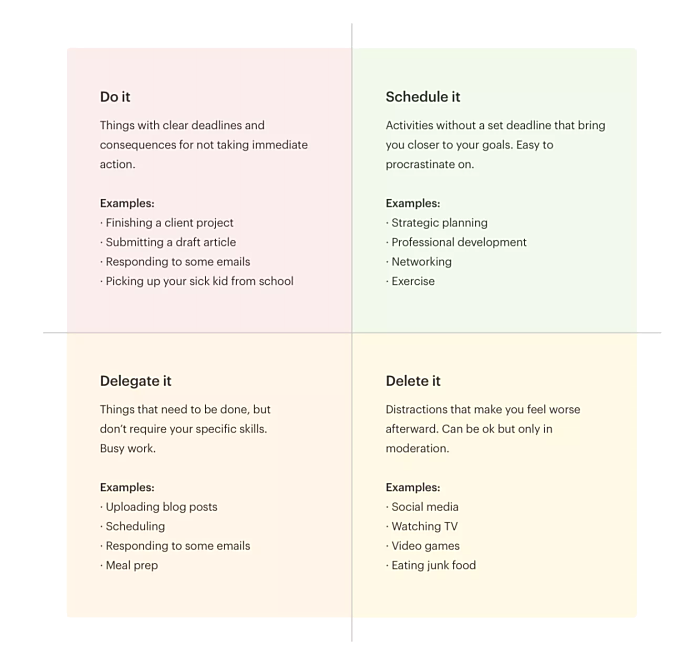
Strategic planning[37]
Benefits
- Provides an anchor to look back to when things change or new opportunities arise;
Creating a strategic plan
- Find time to break away from your schedule and think.
- Clarify your values to figure out your purpose. (If confused, here's a list of values.)
- Create a mission statement that will carry your purpose;
- Figure out your strenghts & weaknesses, e.g. with SWOT analysis;
- Create goals that align with your values
- Under each goal, consider including specific action steps and a time frame
3. Taking breaks[38]
The top 10% most productive people work on average for 52 minutes and then take a break for 17 minutes.[39]
Unproductive breaks
- Social media use (without effective boundaries in place);
- Reading news articles;
- Watching YouTube, Netflix, Twitch, etc.;
- Eating junk food;
- Browsing shopping sites aimlessly.
Reason for being unproductive: they increase dopamine with little effort, causing at the worst case going down a rabbit hole and wasting the rest of the day.
Effective breaks
An effective break is an activity that lets your mind switch from concentration to relaxation. (Don't use the same part of the brain for working and taking a break.)
For example:
- Eat a healthy snack;
- Brew coffee or tea;
- Take a shower;
- Tidy up a part of your room;
- Do a breathing exercise or meditate;
- Lie down with your eyes closed or nap;
- Stand up and stretch;
- Do a quick workout;
- Take a short walk (Studies say that taking a walk through nature boosts your ability to concentrate by as much as 20% and at the same time reduces your stress levels);
- Stare out of a window;
- Read a page of a book or a blog post (This can be a good substitute for social media checking);
- Have a chat with a roommate or a colleague;
- Call someone;
- Doodle.
(Make sure to try all of them — variety is important for high dopamine.)
Tips for effective napping
- Find a place that is as dark as possible;
- Make sure the nap is 10-20 minutes long (longer napping can cause tiredness!); set timer for 25 minutes because it takes time to fall asleep;
- Lay down and relax (don’t tell yourself you have to fall asleep, that way you won’t, maybe try slowing down your breath).
- If you like coffee, consider taking a nappuccino: before the above, drink a coffee to feel awake after the nap (because of caffeine entering the bloodstream).
4. Sleep Strategy
Planning your sleep[40]
- Stick to a sleep schedule. Go to bed at the same time every day, including weekends. (Being consistent reinforces your body's sleep-wake cycle.)
- Pay attention to what you eat and drink. Don't go to bed hungry or stuffed. Avoid heavy or large meals within a couple of hours of bedtime. Other things disrupting sleep are nicotine, caffeine and alcohol. Water is fine, but in small amounts, within 2 hours before sleep[41].
- Create a restful environment. Make sure your room is cool, dark and quiet. Avoid over-exposure to light-emitting screens just before bedtime.
- Limit daytime naps. Long daytime naps can interfere with nighttime sleep. Aim to nap for 10-20 minutes[42] and avoid napping late in the day.
- Include physical activity in your daily routine. Regular physical activity can promote better sleep, but avoid being active too close to bedtime.
- Manage worries. Try to resolve worries and concerns before bedtime. Jot down what's on your mind and set it aside for tomorrow.
Sleep length[43]
On average, a sleep cycle lasts 90 minutes. Adults need at least 7 hours of sleep. Avoid waking up during stage 3 NREM, i.e. between 50% and 75% (the longer the sleep, the sooner) of a cycle, as it may result in an impaired mental performance for 30-60 minutes.
If you awaken spontaneously in the morning, you've most likely been at the last (REM) phase of a sleep cycle.
Falling asleep
Try these tips if you struggle with falling asleep:
- Try to stay awake for as long as possible (without access to television, computer, or moving around at all) to get more tired[44].
- Avoid looking at bright screens two to three hours before bed. (If you can't, consider using blue-blocking glasses or installing an app that filters the blue/green wavelength at night)[45]
- Put a pillow under your knees to avoid rolling into less ideal positions as well as for more back health[46].
- Take deep breaths and count them[8].
Thoughts & emotions
Disclaimer: This section might need consolidation and might be missing significant information.
Contents
- Stress management
- Emotions & thoughts management
- Emotional stability
- Stopping bad habits
- Building confidence & self-esteem
- Meditation
1. Stress management
Short-term solutions. Managing everyday stress
- Plan and keep track of your progress[47]
- Try journaling[48]
- Give your brain regular breaks
- Get enough sleep[38]
- Exercise[38]
- Eat healthy food as it affects your mood, energy and stress level[38]
- Don't put away tasks until the last minute; try to use stress to motivate yourself[38]
- If you're not sure how to deal with a task, consider asking for advice[38]
- Listen to calm, slow music (also recommended for sleep). Some of the most relaxing music include Native American, Celtic, Indian stringed-instruments, drums, and flutes as well as sounds of nature, especially rain and thunder. Don't force yourself to listen to music that you don't like[50]
- Know your strengths (appreciate the things you're good at and other people struggle with); get out of your comfort zone to get feedback to learn more about yourself and the situation and to be more confident[51]
Long-term solutions. Achieving goals without stress[52]
- Set big goals, even bordering with unrealistic, so that you have a chance of reaching something at least close to those goals (crappy goals = crappy results);
- Envision the goals: what are the things you're doing, when are you doing them, where are you; picture everything;
- Review the big goals: keep a journal, meditate on it - do something to constantly remind yourself to focus your unconscious mind on it;
- Break it down into smaller chunks. That way you won't get to a point when you don't know what to do next;
- Attach your emotions and values to it: find ways of connecting things you need in your life - if you don't work towards your goal, you suffer; make it compelling;
- Reduce or eliminate obstacles, e.g. unhealthy obstacles, things compounding waste of time, distractions, etc.;
- Build in the habit through repetition.
2. Emotions & thoughts management
Laziness[53]
"The most difficult part of a behavior is getting started. Once you get started, it's easy to continue even if the activity is not enjoyable. Modify your environment in a way that requires extra effort for keeping negative habits and limited effort for developing new positive habits."[54]
Causes of laziness[53]
- Lack of self-esteem;
- Lack of positive recognition by others;
- Lack of discipline (due to low self-confidence);
- Lack of interest in the activity itself.
Boredom[55]
Boredom happens when none of the available activities are appealing for you at the moment. A common way to escape boredom is the Internet which absorbs all attention.
Inverse relation with learning
In a learning environment, a common cause of boredom is lack of understanding (or the contrary, too simple)
"not challenged enough, or too challenged"
Anger[8]
- "When you get an email or text that infuriates you, wait about an hour to respond. You'll be surprised at how much more rational you become."
3. Emotional stability[56]
Benefits of emotional stability
- enables you to develop an integrated and balanced way of perceiving the problems of life;
- helps to develop;
- reality-oriented thinking;
- judgement and evaluation ability;
- understanding conditions/circumstances that create miserable situations in life.
Emotional stability scale
Five main dimensions of emotional stability
- Optimism vs. pessimism
- satisfied with yourself vs. disappointed with yourself (high vs. low self-esteem)
- positive and persistent vs. depressed and passive
- driven by hope of success (find life rewarding) vs. driven by fear of failure
- seeing failures as manageable circumstances vs. as a personal flaw (and having feelings of guilt and interpersonal dependency)
- at peace with the world vs. at odds with the world
- Empathy vs. apathy
- considers others' feelings vs. interested in self when dealing with others
- altruistic vs. expedient
- trusting, warmhearted vs. detached, shrewd
- straightforward vs. worldly
- Autonomy vs. dependence
- independent vs. submissive
- relies on self when making decisions vs. pushed around by other people and events
- master of their fate vs. helpless pawn of fate
- takes realistic actions to solve their own problems vs. unquestioning submission to higher power
- Calm vs. anxious
- resistant to irrational fears vs. unreasonably worried about the future
- stays calm and thinks clearly under pressure vs. easily upset with failures
- focused vs. restless
- Tolerant vs. aggressive
- efficiently manages impulses [can link to emotional management?] vs. compelled to return fire
- even tempered vs. bad-tempered
- gentle vs. violent
- not given to vs. given to the expression (direct or indirect) of anger, e.g. temper tantrums, fighting, violent arguments, sarcasm; given to activities and scenes of violence
(others are: evenness of moods, intent, interests, cheerfulness, composure, feeling of being in good health, freedom from feeling of guilt, worry or loneliness, freedom from daydreaming, freedom from preservation of ideas and moods)
Emotional instability/immaturity happens when a person is unable to develop a degree of independence or self-reliance that is seen in a normal adult:
- immature adjustive patterns;
- inability to maintain equilibrium under stresses;
- incapable of disposing off problems and irritability;
- need constant help to accomplish day-to-day tasks;
- show vulnerability and stubbornness while looking for sympathy;
- conceited, quarrelsome, infantile, self-centered, demanding.
4. Stopping bad habits[57][improve source?]
You don't want to look back and regret wasted time.
Possible reasons of relapse:
- The end-game goal was too ambitious
- You're not motivated enough
- There are too many old triggers (things that remind you of the habit)
Possible solutions:
- Replace the habit with something that equally satisfies the need fulfilled by the habit.
- Keep yourself accountable by attaching it to other poeple
To find secondary gains, ask yourself:
- What does it allow you to do?
- What does it allow you NOT to do?
5. Building confidence & self-esteem
Mindset[58]
- Confidence is taking an action with the mindset of "I'm going to learn about/from this". (See failures as opportunities, not obstacles[59])
- Give yourself the permission to make mistakes?
- If you're afraid of doing something but you know you need to do it, you should do it.
- Ask yourself what actions should you take.
- Know the purpose of your actions[59]
- Know yourself better. Everybody has something unique to offer due to their unique way of perception, living, thought patterns
- Assess your needs & values[59]
- Learn what limiting beliefs decrease your confidence
Environment
- Maintain a good posture[59]
- Make eye contact
- 80/20 rule: spend 20% time looking at something else not to appear too intense
- Adopt new routines, e.g. exercise or meditation[59]
- Make sure you're not surrounded by demotivating/irritating people[59]
- Read and collect inspirational quotes
- Learn more about topics related with your goals
- Consider learning to play an instrument[60]
6. Meditation
Advantages of meditation
- boosts immune system[61]
- lowers blood pressure[61]
- possibly prevents or at least slows down shrinking of control gray matter (figuring things out, remembering things)[62]; grows gray matter in key areas of your brain (having to do with self-awareness and compassion) and shrinks gray matter in area associated with stress[62] ==> increases focus
- grows hippocampus (learning and memory) and temporo-parietal junction (perspectives, empathy and compassion)[62]
- reduces stress and fatigue[49]
- improves concentration[49]
- helps with relaxation, inner peace, and emotional well-being[49]
Guided meditation[63][64] (from Khan Academy)
Preparation
- Try to sit with your back upright (posture makes a big difference)
- Make sure you're in a peaceful and quiet place
- Put yourself in a rest, effortless position
- Start breathing a little bit slower, a little bit deeper. (You may breath with your nose or mouth, but the key is to breath slower and deeper.)
- Start to soften your gaze if your eyes are still open.
- When you feel comfortable, gently close your eyes.
Remember: there is no perfect way to meditate. This whole exercise is about exploring your inner being, it's about curiosity and relaxation.
If there are random distractions, just accept them. They're just part of the universe.
Path to the heart of meditation
- Give yourself a good smile, even if you need to force it. Try to keep it the whole time. (Keep breathing slower and deeper)
- Take a pause to appreciate that you're alive, to appreciate who you really are.
- Try to become aware of your thoughts. Don't try to fight them, just observe them.
- Start to appreciate that you are not your thoughts because you observe them and see them go by. (One often used metaphor is that thoughts are like cars on a highway, and one thing to observe them is to just get out of the highway.)
- As you observe the thoughts, if they slow down, embrace that feeling. Try to have no thoughts, just breath in and out. If your mind wanders, it's not a big deal.
Ideas to help you appreciate who you really are
- You are not defined by your action, or outcome, or what people think of you. You're pure consciousness.
- Think about how vast the universe is – not just in space, but also in time. That puts some of our problems in perspective. Will they be significant in a hundred or thousand years? Think how small the things that we often define ourselves by really are.
- When you get a chance, gently start to feel the room around you a bit, get in touch with your body.
When you're ready, open your eyes. Take that stillness with you for the rest of your day. Thank yourself for taking your time out for doing this. Consider making it a regular practice.
Developing a meditation habit[65]
Starting seriously (i.e. with large sessions) won't work. Don't worry about the quality of at the beginning. You may e.g. establish a 5-minute habit for the first year, then extend it to 15 minutes the 2nd year, then more. Important: give yourself this opportunity regardless of whether you had a good or bad day.
Other meditation tips
- In terms of how often you should meditate, it's up to you. Some people benefit from sitting once every day, while others prefer a short session in the morning and another in the evening. Sitting more than once a day can help manage overthinking and keep your mind calm and stress-resilient throughout the day.[66]
- There is no universally best time to meditate – each time gives different benefits. Read more here: When Is the Best Time of Day to Meditate?
Organization
Disclaimer: This section is less defined than others and may lack profound sources.
Increasing dopamine levels / building up productivity[67]
- Always have a key objective to work towards and you'll know what you should be doing. Having a clear goal gives your actions a purpose. Setting smaller goals on the way to a bigger goal is also recommended because achieving each goal will give motivation to achieve more goals.
- Make sure the progress is visible. If you have the progress towards multiple goals visible, you'll see you're constantly close to completing something, which makes you keep moving on. Therefore, consider tracking your activities and taking notes of all the things you've done that led you towards your goals.
- Reward yourself. However, make sure your "reward" doesn't actually pull back your progress. Instead, consider rewarding yourself with something that reinforces the progression or habit.
- Make sure there is variety. If you want to stick to something long-term, it helps if you can incorporate something new into the activity, especially something you're not fully familiar with that makes the challenge novel. In short, look for a way to make your day slightly different.
- Match the difficulty to your skill level. Whenever you're able to do so, you'll be more engaged. One way to increase difficulty is to give yourself shorter and shorter time limits to gain more efficiency.
Increasing energy[68]
- Decide that you're not tired. Sometimes being tired is as much of a mental thing as a physical thing – you're gonna act as tired if you identify as tired.
- Do not oversleep – if you start getting up at the same time every day over and over it'll become easier over time
- Get exercise every single day and more intensive exercise every other day as a minimum
- Eat better: 1. dramatically reduce sugar; 2. reduce the amount of carbs (donut, cookie, stuff with sugar), eat complex carbohydrates (brown rice, potatoes, etc.; 3. eat more dark greens (spinach, kale); 4. drink lots of water)
- Perform a mid-day reset. (1. go for a short walk; 2. meditate; 3. go to the gym) (click here for more effective breaks)
How to absorb textbooks like a sponge[69]
- Flip through each page. Take the beginning of the chapter and turn page by page just to see what's on each page, don't read anything, just look what the pictures are and what the pages look like, to get a sense of how long a chapter is, how much words are there compared to images, are there any graphs, does anything jump out, etc.
- Go to the end of the chapter to see if there is any sort of a quiz. Read the questions to know what to look for / what to get out of the chapter.
- Go back to the beginning and read the bold print (only) to understand how this stuff fits together.
- Go one more time, read the first and last sentence in each paragraph. The first sentence, if it's well-written, provides a good introduction and gives an indication of what the rest is about. The last sentence usually helps you sum it up. Don't read for comprehension, read for exposure.
- Read the chapter and take notes on it.
(Repetition is the mother of learning.) (Reticular activating system – activate it before you read the chapter to heighten your awareness.)
More on self-discipline[70][?]
- When you wake up, you need to have a routine to keep the rest of your day in a positive way. Wake up with intention and willpower to set things in a positive way. Failing in the beginning makes it harder to succeed later.
- Try getting up earlier to get more time to change your life and make more impactful decisions.
- Track your progress by the end of the day to appreciate your wins – we often don't realize how successful we are.
- Set up your tasks (at least the most important ones) for the next day in advance.
- If you need to focus on a goal, draw grids and a target[8].
- Regard every task as an exercise. It will make you stronger, more decisive and more confident[8].
Keys to Creative Collaboration[71]
- Ownership. Make members able to solve problems, generate ideas, design systems that lead to success.
- Dependability. Ensure deadlines and creative endurance are enforced.
- Trust makes members work interdependently. That way they can assume the best in each other.
- Structure – loose and flexible, but has to exist.
- Shared vision. Make sure there is a shared direction, desire, goal.
- Fun makes members want to be together and boosts both convergent and divergent thinking.
- Candor. Groups need to be honest about what's working and what's failing in order to adjust and iterate and ultimately achieve success.
Communication
Disclaimer: As of now, this section might be missing significant information, as two sections are being reworked.
Contents
1. Styles of communication (Marston's DISC model)[72][73][74]
(median reliability coefficient = .86)[73]
Overview[72]
The model is based on two dimensions:
- Sense of self (whether a person views their environment as favorable or unfavorable)
- Interaction with the environment (whether a person perceives themselves as having control or lack of control over their environment)
The model is not prescriptive, i.e. each person is considered to be a blend of styles with one stronger and one weaker.
See also: Tony Robbins's four personality needs (certainty vs. variety, significance vs. connection)
Styles[73][75]
- Compliance: logical, analytical, formal, detail-focused
- Likes written communication, factsheets, etc. (dislikes analytical topics)
- Motivated by planning and preparation
- Steadiness: careful, patient, calm, stable, systematic, sincere
- Likes listening, one-to-one conversations, talks when asked
- Motivated by instructions and concrete tasks
- Influence: social butterfly, quickly likeable, pleasant, spontanic, variegated
- Likes attention, variety, newness, emotions, crossing the limits
- Motivated by the possiblity to influence and impress
- Dominance: man of action, result-oriented, distanced, direct, concrete
- Likes action, goals, tasks, decisions
- Motivated by challenge, action, freedom, and rivalry
Improvement tips[74]
- Compliance: speak more (but less on facts & numbers), be expressive & inspiring, spend more time on open-ended conversations
- Steadiness: speak more and faster, be more expressive, contol your emotions, don't focus on details, be more result-oriented
- Influence: listen more than speak, slow down, be more direct, focus on facts & details, don't get overly emotional, try to stick to the topic
- Dominance: listen more than speak, slow down, be more patient, focus on feelings & emotions, try not to dominate the conversation
2. Non-verbal communication[76]
Some facts[messy]
- The majority of communication is done non-verbally. Non-verbal communication is about negotiating interpersonal relations.
- Women are innately better at recognizing non-verbal cues than men.
- Before you think you suck at body language, realize there are many universal gestures, such as smiling, frowning, nodding/shaking your head, baring teeth, shoulder shrug
- Gestures can often appear in clusters and, as such, often have to be examined together.
- It's important to consider what effect a person’s physical restrictions or disabilities may have on his or her body movement.
- "as an individual gets older, many of his gestures become sophisticated and less obvious"
- It is generally considered impossible to fake body language, especially for longer periods of time, due to likely lack of congruence between main gestures, microsignals and spoken words.
- Indicators of lying: facialmuscular twitching, expansion and contraction of pupils, sweating at the brow, flushing of the cheeks, increased rate of eye blinking, etc.
Zones
- Intimate Zone: 15-45 cm (6-18 inches) – only for emotionally close people
- Personal Zone: 46-122 cm (18-48 inches) – distance during social functions and friendly gatherings
- Social Zone: 1.22-3.6 m (4-12 feet) – for strangers and people we don't know very well
- Public Zone: over 3.6 m (12 feet) – for adressing a large group of people
The denser the space you grew in, the smaller the zones.
Implications
Body language will not work the same way in intimate zone and may be interpreted as negative. Keep the right distance for people to feel comfortable in your company. When one reacts negatively to approaching their zone, they may lean back to maintain a comfortable distance.
"Advance" is a technique of approaching one's intimate zone and seeing if it's accepted.
Territories
Everyone has their territories which are places and objects which they perceive as "theirs"; they are usually determined by usual presence or personal objects left in it.
Claiming another person's territory may cause negative results.
Territorial gestures
- leaning against newly acquainted property, putting foot or arm around it = pride of ownership
- leaning against, sitting upon or using another person's property are subtle intimidation techniques
- leg-overchair signifies ownership and implies relaxation to others
Palm gestures
open palms = honesty (hiding palms in pockets or in the back suggests dishonesty)
Palm command gestures
- palm facing up = submissive
- palm facing down = dominant (acceptable when you have authority, otherwise may be seen as antagonistic)
- palm closed with finger pointed = irritating, aggressive, non-relaxing
Handshakes
- palm facing down = dominant
- palm facing up = submissive (avoid)
- vertical palm grip is a sign of respect as both sides try to be dominant
Technique for disarming dominant shaker:
- step forward with left foot as you reach to shake hands
- bring the right leg forward, moving left in front of the person
- bring your left leg across to your right leg to complete the manoeuvre, then shake the person’s hand
Initiate handshake when: (you aren't unannounced nor uninvited)
- you are welcome
- the person is glad to meet you
Handshake styles
- palm-down thrust: most aggressive handshake style. Methods to counter:
- (see above)
- grasp the person's hand on top and shake (caution – can be embarrassing to the aggressor)
- glove handshake (aka. politician's handshake): displays trustworthiness and honesty unless the person is newly met
- dead fish handshake: displays weakness, easy for others to turn up palm; often used by unaware people
- knuckle grinder: aggressive, cannot be countered
- stiff-arm thrust: aggressive, used when trying to maintain distance (avoid)
- finger-tip grab: same as above, displays lack of confidence (avoid)
- arm pull: used by people who are either insecure or have a small intimate zone
- double-handed handshake: shows sincerity, trust or depth of feeling
- elbow grasp transmits more feeling than wrist hold, shoulder hold or upper arm grip
- wrist hold and elbow grasp are accepted only between close friends/relatives
- shoulder hold and upper arm grip should be only used between people who have a close emotional bond
Hand and arm gestures
Hand gestures
- rubbing palms together = positive expectation (in case of waiters may be used when expecting a tip)
- quickly = to your benefit
- slowly = crafty, devious, to their benefit
- rubbing thumb agaist other fingers = money expectancy (avoid at all times)
- hands clenched together = frustrated, hostile, negative
- in front of the face (most negative mood, difficult to handle)
- resting on the desk
- lower (lap when seated or in front of the crotch when standing)
- "steepling" hands = confidence, superior, know-it-all (can be either positive or negative, depending on preceding movements)
- raised = giving opinion (head tilted back = smugness, arrogance)
- lowered = listening rather than speaking
Gripping
- hand grip = superiority, confidence (fearlessly exposes vulnerable regions)
- wrist grip = frustration, attempt at self-control
- upper arm grip = even more frustration and attempt at self-control
Thumb gestures
Thumb gestures are secondary, used to display dominance, superiority or even aggression.
- Can be used as a signal of disrespect when pointing at another person
Hand-to-face gestures
- "hear no evil, speak no evil, see no evil" gestures = deceit, untruth (don't interpret in isolation)
- mouth guard (hand covers mouth, thumb pressed against cheek) (not to be confused with evaluation gesture)
- when they are speaking = being dishonest
- when they are listening = considering one as dishonest
- nose touching is a more sophisticated version (light strokes rather than deliberate rubbing when nose itches)
- eye rub (more rubbing = bigger lie, may even cause looking elsewhere)
- ear rub
- variations: rubbing the back of the ear, the finger drill, pulling at the earlobe or bending the entire ear forward to cover the earhole (last one = the person may have heard enough and wants to speak)
- mouth guard (hand covers mouth, thumb pressed against cheek) (not to be confused with evaluation gesture)
- neck scratch = doubt, uncertainty, not agreeing
- collar pull = lying, deceit OR anger, frustration
- palm rubbing back of the neck = negative, critical, also frustration and anger (as opposed to rubbing forehead = open, easy-going about an error)
- fingers in the mouth = under pressure (give guarantees and assurances)
It's easy to misinterpret these gestures if they appear isolated.
Hand to cheek and chin gestures
- supporting head on hand = boredom (the more supporting, the more bored)
- drumming fingers on the table, tapping feet on the floor = impatience (faster = more impatient)
- hand resting on cheek, often with index finger upwards = evaluation (interested; if hand starting to support head – less interested)
- index finger vertically on cheek and thumb supporting chin = negative/critical thoughts
- chin stroking = making a decision (observe other gestures to know attitude)
- putting an item (e.g. glasses frame, pipe) in one's mouth = unsure
- combined gesture: evaluation moved to chin, hand stroking chin
- thumb supporting head = less interest
Arms gestures
- arm folded across chest = defensive, critical (more firm/tight = more defensive) -> may be negative and pay less attention
- standard (both arms folded together) = defensive or negative attitude; uncertain or insecure (often when disagreeing)
- reinforced arm-cross (above + clenched fists) = hostile, attacking attitude
- arm gripping = negative, restrained, nervous
- partial arm barrier, holding hands with oneself = stranger, lacking self-confidence
- disguised arm crosses (one arm touching an object on or near the other arm) – used by people constantly exposed to others to cover uncertainty or nervousness
Leg gestures
- crossed legs = negative or defensive attitude (though less than arms)
- standard: nervous, reserved or defensive (often supportive, don't interpret in isolation!)
- combined with arms = withdrawn from conversation
- hand clamp on legs = tough-minded, stubborn
- standing leg cross (often at a greater distance) = stranger defensive
- ankle lock = same; "holding a valuable concession"
- foot lock (top of one foot locking around the other leg; often used by women) = very defensive
- leg lock (one leg on another) = superior, likely wants to argue
Head gestures
Basic head positions
- head up = neutral attitude (often used with hand-to-cheek evaluation)
- head tilt = interest
- head down = negative, judgmental, critical or hostile
Other
- hands behind head = confident, dominant, superior, know-it-all (copy to handle)
Eye signals
(Have cultural circumstances in mind)
- dilated pupils (up to 4 times than normal) = excited
- babies dilate pupils to receive attention
- constricted pupils ("snake eyes") = angry, negative
- eyes meeting less than 1/3 of the time = likely dishonest
- eyes meeting more than 2/3 of the time = interested (dilated pupils) OR hostile (constricted pupils)
Gazes
- Business gaze: triangle on the other person's forehead – creates serious atmosphere
- Social gaze: triangle below the other person's eyes
- Intimate gaze: across the eyes and below the chin
- Sideways glance – interest (with slightly raised eyebrows) or hostility/suspiciousness (with down-turned eyebrows, furrowed brow or the corners of the mouth down-turned)
- Eye block (i.e. blocking from sight) = bored, uninterested or feels superior
Controlling one's gaze (e.g. when explaining sth)
- Use a pen or pointer to point to the visual aid while verbalizing it
- Lift the pen and hold it between your and their eyes to achieve maximum absorption of the message
- Make sure your palm is visible while speaking
Cigars, cigarettes, pipes gestures
- smoking = inner turmoil or tension
- non-smoking people instead do grooming, nail biting, finger and foot tapping, cufflink adjusting, head scratching, taking a ring off and putting it back on, playing with a tie
- pipe smokers may perform a cleaning, lighting, tapping, filling, packing and puffing ritual to relieve tension
- cigarette smokers may perform tapping, twisting, flicking, waving and other mini-gestures
- blowing smoke upwards = positive, superior or confident; down = negative/secretive (unless blown through nostrils) (faster blowing = more)
- continual tapping of a cigar or cigarette end on the ashtray = inner conflict
Glasses gestures
- placing one arm of the frame in the mouth = reassurance, reliving security; can be used to stall or delay a decision
- continual taking glasses off and cleaning lenses = taking time for a decision
- folding glasses and putting away = intent to terminate conversation ([on the contrary] putting them back on = wanting to "see" the facts again)
- peering over glasses = critical, judgmental
Uncategorized
- leaning forward = interested
- standing/sitting behind an object (e.g. chair) = protected, dominant, aggressive
- picking imaginary lint of clothing = disapproval
- hands on hips = aggressive, often ready to take action, goal-directed (also consider immediately preceding gestures) (may be done with one hand on hip and another displaying another gesture)
- open coat, pushed back = ready, fearless, directly aggressive
- closed coat = aggressive frustration
- turned at an angle + relaxed lower body = just evaluating (otherwise trouble brewing)
- both hands on knees (or gripping chair) + leaning forward = desire to end conversation
- thumbs tucked on the belt or tops of pockets (often accompanied by expanded pupils and foot pointing) = sexually aggressive attitude
- copying another person's gestures = in agreement (effective for disarming "superior" types who try to take control; forces them to change position)
- lowering the height of one's body in front of another person = establishing superior/subordinate relations
- tall people command more authority (but can be detrimental when wanting to "talk on the same level")
Feet pointing
- Body (feet, torso) pointing elsewhere than you even if head doesn't = mind doesn't want to be there
- Open formation (bodies angled towards third imaginary point forming a triangle) = invitation to conversation
- Closed formation (bodies angled 0 degrees; usually smaller distance) = intimacy required
Knees
- crossing knees towards someone = acceptance or interest
Seating positions
- corner position (in a 90-degree angle to someone) = friendly, casual; good for delivering presentations
- co-operative position (next to someone) = thinking alike, working on sth together; good for presenting a case and also for inviting new people to the conversation
- competitive-defensive position (opposite someone) = competing, reprimending, creating superior/subordinate relations; good for persuading someone; avoid in negotiations and discussions
- independent position (none of the above) = no wish to interact, lack of interest
Impact of table shape
- square = formal, for short and to-the-point conversations
- round = informal, relaxed & equal atmosphere
- recrangular: furthest person has greatest influence unless their back faces the wall
Impact of chair shape
- taller back = higher status
- swivel chairs give more status than fixed chairs
- arm rests = higher status
- chair adjusted higher
- social or public zone = more status
Other status raisers
- low sofas for visitors
- expensive ashtray out of visitor's reach
- red folders left on the desk marked as confidential
- a wall covered with photos, awards or qualifications of the occupant
- a small briefcase with a combination lock
Trivia
- most men put on a coat right arm first while most women put it on left arm first
- when a man passes a woman in a crowded street, he usually turns his body towards her as he passes while she usually turns her body away from him
3. Effective communication[77]
Common barriers to effective communication include:
- Stress
- Lack of focus (checking your phone, planning what you're going to say next, daydreaming)
- Lack of engaged listening
- Inconsistent or negative body language
Other Tips[unorganized]
Discussion tips[8]
- While arguing, stand next to the concerned person to effectively make your point clear.
- The most powerful way to win an argument is by asking questions.
Other[8]
- When meeting someone for the 1st time, ask them what they like to do, rather than what they do. It'll get them excited and spark conversation.
- If you want to check if the other person is listening, just cross your arms.
Creativity
Disclaimer: Currently this section relies largely on one book and may need expansion.
“Things are not difficult to make; what is difficult is putting ourselves in the state of mind to make them.” – Constantin Brancusi
Contents
1. The Two Thinking Modes[78]
- Convergent (Focused): narrows things down to a single solution
- Divergent (Diffuse): connects a wide variety of things to generate new ideas
Both are needed for creativity. The challenge is to balance them.
2. The Four Stages of Creativity (G. Wallas)[78]
Purpose: lessen fatigue and prevent creative burnout.
- Preparation: Learning everything you can about the problem, trying different combinations (to find connections that work). Aim to do it so well that you don't need notes.
- Incubation: Recovery from fatigue of above. Happens anytime you're not working on the problem, including sleep.
- Illumination: Moment of insight. Sudden, effortless, unpredictable.
- Verification: Evaluation of the idea; finishing touches.
The stages don't have to happen one after another and can take varying amount of time to progress (most commonly weeks or days).
(In short: First have some tedious research, then wait & recover, and see the solution come out of nowhere)
The importance of Preparation
Relying solely on short-term memory decreases brain power and it makes it harder to follow. Preparation helps manage the situation in such way to bring only new concepts to short-term memory (while retaining the big picture in the long term memory).
The importance of Incubation
Incubation is important to forget about bad ideas and fixations. Otherwise you may end up in an impasse because of using too much brain power on connections that don't lead to a solution. (Creativity can't flow through bad ideas jammed together.)
"Alternating incubation method" – two similar creative projects intersecting
3. The Seven Mental States (D. Kadavy)[78]
Purpose: approaching your work in the wrong mental state can create a creative block
- Prioritize: see the layout, create the plan, decide what needs to be done and how, and what needn't to (good to start with when you've done similar things before);
- Explore: delving into random stuff, satisfying curiosity, trying things without knowing if they'll work (good when you don't have a clear vision);
- Research: specific research for how to structure something or getting facts straight; answering questions (good when you know what you want)
- Generate: creation using shippable ideas (tying together stuff from Explore and Research and fleshing out Prioritize);
- Polish: take off the rough edges, grammar, spelling, unsure things
- Administrate: reviews, keeping things clean and right outside (taking care of details that make creative work possible)
- Recharge: refueling, relaxation (good when project is too big to picture in mind)
While the Four Stages are about project state, the Seven States are rather about the mood you are in during work.
Switching states too often can cause a block (creates an excuse for distractions).
Encouraging states
Different stuff work for different people.
Chain a cue with other cues to design a routine (which can be anything) to get in a state.
Match your mood to your work
Three questions:
- What kind of work do you need to do right now?
- What mood do you need to be in to do that work?
- When was the last time you felt that way?
4. Environment setup[78]
- creative = open space
- analytical = closed space (less than 3m height)
- 70dB background (indistinct!) noise is optimal for idea generation
- sitting is not good for divergent mindset
- also reclining is good for creative work
- getting physical (walks, exercise) is also good for creative work
Building creative endurance[79]
List what you do in a day to find time for creative activities. Look for activities that don't add value to your life such that you'd want to reduce or eliminate and consider scheduling a creative activity (10 minutes per day Is a minimum to build creative endurance). Once it's stable, set a goal.
Creative activities
Disclaimer: Unlike the above, this section features few credible sources, relies on loosely collected information, and needs improvement and consolidation.
Contents
1. Music
Orchestral tips[80][81][82]
- Different types of instruments play different melodies, and when one type takes over the melody, other move to the background;
- If one instrument is doing something, other instruments from that type are going to do that too;
- When composing, think of what different groups of instruments should take on instead of individual instruments;
- Save some instruments to add them later for more power in the right areas.
Music performs three functions / operates in three different ways:
- With an ensemble, as a chorus (or a pad): rich, thick chords
- As a melody line (top line, cello line, altering phase, and/or instruments in the middle)
- Form an accompaniment
- Limit the amount of voices in strings (in big strings, big gaps work well)
- Strings as an accompaniment work different than a piano (which has more of a percussive sound structure); one way to deal with it is the ostinato
- For cello and bass as an accompaniment, it's good to use pizzicato
- For the top line, use legato
- Fill the gap between top strings and low strings with brass
The most important tool is not the theoretical knowledge. In fact, the lack of theoretical knowledge can help you sculpt a style that is unique to you.
When composing for violin or cello:
- Give it some motion: make the lines feel musical instead of making them feel like pads
- Use multiple stops (multiple notes played under a single bow) to create interesting background patterns: create wide, open arpeggios
- Double check your multiple stops
- Use two bows to a bar (generally)
- Don't overdo high notes: they won't be too strong without the rest of the orchestra. Support high notes by doubling them an octave down
- Make good use of scales and arpeggios
- Make use of all the "colors" of strings (pizzicato, tremolo, etc.)
- Pass the focus between different instruments and don't rely on one instrument all time
- Plot out the chords using four part chorale style (check) and then carve interesting rhytms out of it
- Consider the rule of 3: no more than 3 ideas at a time
- Be careful of extra wide leaps and other hardly playable stuff
- Take advantage of the deep strings for full body sounds. However, avoid doing the bass part too much with full notes
- Consider pushing the extremes of the dynamics
- When arranging, the fewer instruments, the better
- Focus on a sound section by section
- Take advantage of the gaps to add strings for sweetiness
Mixing[83][84][85]
Rules of mixing loud:
- Manage the dynamic range of each element
- Have enough high-mid frequencies
Types of volume:
- Peak volume - the loudest part that a signal gets
- RNS volume - average level of the signal over the past half a second or so
The further they are from each other, the larger the dynamic range is.
Compression is making the dynamic range smaller. To compress, you set a threshold, and whenever a signal tries to get over the threshold, you push it down towards it, or vice versa. (Downward and upward compression)
Expansion is making the dynamic range larger. To expand, you push the signal up further away from the threshold (upward expansion), or down further away from it (downward expansion or gating).
Consider mastering downward compression first.
Compression
Compression compresses the loud part so that it becomes more quiet; thus, after rasing the gain, both the quiet and loud parts are full and hearable.
Core principle: Don't compress in solo (unlike other effects, compression is about dynamics, levels and transcience, therefore you need to hear the other instruments)
Essential compression settings:
- Threshold: the point or level in dB where the compression will start being applied.
- Ratio: determines how much compression is added (2:1 = gentle, 10:1 = agressive)
- Attack: how fast should the compression start after the threshold is passed
- Release: the speed at which the compressor recovers after the signal falls below the threshold
- Makeup Gain: a boost at the end to bring the audio signal back up to the original level; with this boost applied and the peaks brought down, the overall signal is louder and more full
- Knee: makes the threshold act more smoothly, so that compression is triggered in a more smooth and gradual manner
It's OK to add the compressor after the EQ.
Limiter
- Ceiling/treshold: any signal that goes above it gets turned down
To compress using a limiter, use the threshold, and then turn up the volume to get the quietest and loudest parts of the signal clorser to each other. It is not recommended to push below -6dB with a limiter because it introduces quite a lot of distortion to the signal.
Tips for staying productive[86]
- Release yourself from pressure. Have a goal, but set your mind free from restrictions.
- Take consistent breaks and remove distractions.
Tips for staying inspired[87]
- Make composing physical
- Stay inspired to be inspired. Listen to music that inspires you, dive into it
- Analyze ask yourself what makes you like it and what makes it unique
- Go outside
- Do something not related to music
- Surround yourself with likeminded people
- Don't be too hard on yourself. The creative process carries in its essence a great sense of insecurity due to imperfections. (These insecurities are, unfortunately, part of the creative process.) Just remember there's a piece of yourself in there.
Improvisation[source?]
Playing a lot of the same lines?
- Start on a different note
- Start on a different beat
- Start in a different direction
Music as a job[88]
{Warning: lots of questions.}
- Money. It's better not to focus on music as your only job, music most likely won't make you enough money (not nothing, but not everything). If you want to switch to music full-time, consider:
- Whether you have a savings account - think how long are you going to survive if things possibly don't work out.
- How much money do you actually need to make: 1) in order to survive; 2) in order to survive comfortably (i.e. what lifestyle are you comfortable with?).
- Transition Period. Can you change jobs? How will you change? Can you test the water out a bit? Consider slowly transitioning.
- Protip: diversify your income. Do a lot of different things, so that if one thing doesn't work, others still do. Think how can you diversify your income.
- Strategy. When you have a plan, take steps to actually make it happen. Know your skills and how you can use them.
- Make a list of your goals because 1) it gives you a set of things you want to accomplish; 2) it gives you a set of things to map out - how are you going to get from A to B, etc.
- If you think you're entitled to success, you really have to change that mindset.
- Connections and network. By being good at networking and dealing with people, you can make yourself successful.
- Business skills. Make deadlines, manage your projects. Think how to brand yourself, set up and manage your reputation.
- Consider 1) how will you find work; 2) how will you keep it coming in.
- Skills. What can you do: that makes you good, special, that gives you the advantage over others who do similar things? Also, what don't you do? What are your weaknesses and which of them represent a challenge? Knowing what you don't know is a big advantage.
- Time management. Are you actually good at managing your time? Know how long it takes for you to complete things and how to manage your time to perform better.
- How are you good at multitasking?
- How are you going to hold yourself accountable?
- How do you work effectively and how you're making sure about it?
- Motivation. It's a big part of composing as well as other creative work.
- How do you intend to keep yourself interested & engaged? Challenge yourself in a variety of creative ways.
- How do you work when you have to work long hours?
- Never think you know everything; expose yourself to people in the same industry. Always learn something new, try new things to keep it interesting.
- Life. Where do you sit in life in terms of your obligations? Do you have people that depend on you? Look at the bigger picture, the long-term plan. What are your aspirations beyond music? Consider what sacrifices are you willing to make to achieve what you want.
2. Writing
Essential story requirements
Exurb1a's criteria for stories[89]
Stories have to be:
- About someone we understand;
- Set somewhere vaguely interesting;
- Propose something, anything even remotely new that we haven't thought about too much before.
Six essential questions[90][unnecessary?]
- Who is it about?
- What did they want?
- Why can't they get it?
- What did they do about it?
- Why doesn't that work?
- How does it end?
Style[91]
Showing vs. telling
Telling is broad, direct, simplified Showing is specific, indirect, complex
Most novels are a blend of both.
Six principles for strong "showing"
- Use evidence to support your claims. When it comes to assumptions or opinions, give the same evidence the character uses, whether it's visual evidence or a piece of dialogue, and allow the reader to come to their own conclusions.
- Replace the abstract with the concrete. Abstract concepts such as feelings have to be demonstrated with concrete details. Replace emotions with character actions that allow the reader to infer the emotion and describe what causes feelings instead of explicitly stating them. Consider the effect of details, not the cause.
- Substitute vague descriptions with specific sensory details. Give unique, specific details to make feelings and scenes "jump off the page". When showing the details, try to go beyond the obvious by giving constrasting details.
- Avoid relying too much on body language. Instead of making body language unusually common (making the description less subtle and more melodramatic), explain the emotions through actions or thought processes whenever possible. Giving real-time account of the character's thought process and interactions can show emotional nuance better than body language. The reader will deduce the emotions based on the thoughts and actions.
- Show emotion through dialogue. Based on the tone alone, the reader can assume what the characters are feeling. Don't show the character's intention twice when the dialogue already does it.
- Filter observations through the narrative voice. Write information that is for the character's benefit, not the reader's. Give details that allow the reader to feel more connected to the point of view of a character. Don't present information like a dictionary definition, but rather an in-world reference that fits naturally into the story. Filter world-building expositions through the characters' perspective.
Places to consider telling (or blending telling & showing)
- Moments unimportant to the larger narrative (how a character got from A to B)
- Summaries of routines, time passing, repetitive conversations
- Some aspects of magic systems or sci-fi world-building
- Character thoughts
- Occasional backstory and exposition
Places to consider showing
- Emotions
- Sensations
- Thoughts
- Opinion-related adjectives
- Flat phrasing
Good writing invites the reader to visualize the scene and experience the emotions themselves rather than being told how to feel.
When giving information, avoid "solving the problems" for the reader and instead give them the equation itself. Well-organized absence of information is what draws in. Imply the meaning rather than pointing it out to provide a way to discover.
Writing strategies[needs expansion]
- "The secret to writing is getting started, and the secret to getting started is by writing."[92]
- The work is always accomplished one word at a time. (Stephen King)
Comments in writing[no source]
A quick comment system can help you focus more on what to write rather than what you've already written.
My comment system:
- [a] = add
- [r] = rephrase
- [w] = change the word
- [v] = verify
- [?] = questions a word/phrase (or a comment itself)
References
Disclaimer: Most of the following references were auto-generated and may not be perfect.
Health
- Ergonomics Made Simple: A formula for health | Ergotron. (n.d.). Ergotron. https://www.ergotron.com/en-us/ergonomics/ergonomic-equation
- Rachel. (2019, May 28). Digital Eye Strain Is No Joke. Follow These Steps To Save Your Vision. John O’Connor Optometrists. https://www.johnoconnor.co.nz/digital-eye-strain/
- Kennedy, N. (2018). My glasses are always dirty! What should I do? They are driving me crazy!! Kilcullen Optician - Nichola Kennedy Kilcullen Optometrist. https://www.kilcullenoptician.com/my-glasses-are-always-dirty-what-should-i-do-they-are-driving-me-crazy/
- Harvard Health. (2020, August 1). Three moves for better spine health. https://www.health.harvard.edu/staying-healthy/three-moves-for-better-spine-health
- TED-Ed. (2015, March 5). Why sitting is bad for you - Murat Dalkilinç [Video]. YouTube. https://www.youtube.com/watch?v=wUEl8KrMz14
- Thomas, Z. (2023, April 4). Are kneeling chairs good for you? https://www.posturite.co.uk/blog/kneeling-chairs-actually-good
- Yetman, D. (2021, April 15). The Benefits of Sleeping with a Pillow Between Your Legs. Healthline. https://www.healthline.com/health/sleeping-with-pillow-between-legs
- Crumblyy https://crumblyy.com/
- Healthy eating plate. (2023, January 31). The Nutrition Source. https://www.hsph.harvard.edu/nutritionsource/healthy-eating-plate/
- Healthdirect Australia. (2023, August 15). Junk food and your health. Healthdirect. https://www.healthdirect.gov.au/junk-food-and-your-health
- Benefits of physical activity. (2023, August 1). Centers for Disease Control and Prevention. https://www.cdc.gov/physicalactivity/basics/pa-health/index.htm
- Big Think. (2022, August 21). Harvard professor debunks the biggest exercise myths | Daniel Lieberman [Video]. YouTube. https://www.youtube.com/watch?v=n6AwsVGJDOY
- https://www.dynamicsc.com/blog/5-Common-Push-Up-Mistakes-You-Could-Be-Making
- Rushlow, A. (2019, February 25). Are you doing pushups wrong? Men’s Health. https://www.menshealth.com/fitness/a19519417/are-you-doing-pushups-wrong/
- https://healthyliving.azcentral.com/build-muscle-fiftyfiveyearold-man-2088.html
- Heath, S. (2023, July 12). The Ultimate guide to building muscle mass | Everyone Active. Everyone Active. https://www.everyoneactive.com/content-hub/gym/eight-tips-help-build-muscle-mass/
- Kolata, G. (2015, November 9). Data on benefits of lower blood pressure brings clarity for doctors and patients. The New York Times. https://www.nytimes.com/2015/11/10/health/data-on-benefits-of-lower-blood-pressure-brings-clarity-for-doctors-and-patients.html
- High blood pressure symptoms, causes, and problems | Cdc.gov. (2023, August 29). Centers for Disease Control and Prevention. https://www.cdc.gov/bloodpressure/about.htm
- LeWine, H. E., MD. (2022). What is the ideal blood pressure number? Harvard Health. https://www.health.harvard.edu/staying-healthy/what-is-the-ideal-blood-pressure-number
- When To Worry About Low Blood Pressure | Premier Health. (n.d.). Premier Health. https://www.premierhealth.com/your-health/articles/women-wisdom-wellness-/when-to-worry-about-low-blood-pressure
- Nidirect. (2021, June 27). Low blood pressure (hypotension). Nidirect. https://www.nidirect.gov.uk/conditions/low-blood-pressure-hypotension
- Prevent high blood pressure | Cdc.gov. (2023, March 17). Centers for Disease Control and Prevention. https://www.cdc.gov/bloodpressure/prevent.htm
- Lindberg, S. (2023, March 21). Cold Showers vs. Hot Showers: Which One Is Better? Healthline. https://www.healthline.com/health/cold-shower-vs-hot-shower
- Big Think. (2014, August 19). Dan Harris: Hack Your Brain’s Default Mode with Meditation | Big Think [Video]. YouTube. https://www.youtube.com/watch?v=FAcTIrA2Qhk
- 12 Tips to Improve Hearing and Prevent Hearing Loss. (2022, November 22). CareCredit. https://www.carecredit.com/well-u/health-wellness/improve-your-hearing/
- Oral Health Tips | Cdc.gov. (2023, April 10). Centers for Disease Control and Prevention. https://www.cdc.gov/oralhealth/basics/adult-oral-health/tips.html
- Schneider, K. (2022, December 13). Here’s how often you should wash your hair. Cleveland Clinic. https://health.clevelandclinic.org/the-dirty-truth-about-washing-your-hair/
- Pros, H., & Pros, H. (2022). How to prevent and reduce chlorine damage | Hair Professionals Career College. Hair Professional Career College. https://hairpros.edu/chlorine-hair-what-happens/
- Cafasso, J. (2020, July 13). What’s the proper order to use shampoo and conditioner while bathing? Healthline. https://www.healthline.com/health/beauty-skin-care/shampoo-or-conditioner-first#how-to-use-them
- Norris, T. (2019, October 24). How to use hair conditioner. Healthline. https://www.healthline.com/health/how-to-use-hair-conditioner#how-to-apply-conditioner
- Skin care: 5 tips for healthy skin. (2022, January 22). Mayo Clinic. https://www.mayoclinic.org/healthy-lifestyle/adult-health/in-depth/skin-care/art-20048237
Time Management
- Rampton, J. (2018, September 4). 6 Time management tips for naturally disorganized people. Entrepreneur. https://www.entrepreneur.com/living/6-time-management-tips-for-naturally-disorganized-people/319304
- Team, C. (2019). Time management. Corporate Finance Institute. https://corporatefinanceinstitute.com/resources/management/time-management-list-tips/
- Best ways on how to plan your day to succeed | Tonyrobbins.com. (2023, April 5). tonyrobbins.com. https://www.tonyrobbins.com/importance-time-management/how-to-plan-your-day/
- Fournier, C. (2020). Are Shorter Working Days The Secret To A Happier, Healthier And More Productive Life? Youmatter. https://youmatter.world/en/schedules-working-days-productivity/
- Wikipedia contributors. (2023). Time management. Wikipedia. https://en.wikipedia.org/wiki/Time_management#The_Eisenhower_Method
- Create your personal strategic plan. (n.d.). ASAE. https://www.asaecenter.org/association-careerhq/career/articles/career-management/create-your-personal-strategic-plan
- How to take effective breaks (and be more productive). (n.d.). https://www.deprocrastination.co/blog/how-to-take-effective-breaks-and-be-more-productive
- Gifford, J., & Gifford, J. (2023). Secret of the most productive people - Breaking | DeskTime blog. DeskTime Insights. https://desktime.com/blog/17-52-ratio-most-productive-people
- Sleep tips: 6 steps to better sleep. (2022, May 7). Mayo Clinic. https://www.mayoclinic.org/healthy-lifestyle/adult-health/in-depth/sleep/art-20048379
- Is It Healthy To Drink Water Before Bed? (2023, April 24). Cleveland Clinic. https://health.clevelandclinic.org/drink-water-before-bed/
- Napping: Do’s and don’ts for healthy adults. (2022, November 9). Mayo Clinic. https://www.mayoclinic.org/healthy-lifestyle/adult-health/in-depth/napping/art-20048319
- Patel, A. K. (2022, September 7). Physiology, sleep stages. StatPearls - NCBI Bookshelf. https://www.ncbi.nlm.nih.gov/books/NBK526132/
- In59seconds. (2015, March 10). How to fall asleep [Video]. YouTube. https://www.youtube.com/watch?v=ZXt3brOQwKw
- Harvard Health. (2020a, July 7). Blue light has a dark side. https://www.health.harvard.edu/staying-healthy/blue-light-has-a-dark-side
- Yetman, D. (2021b, April 15). The Benefits of Sleeping with a Pillow Between Your Legs. Healthline. https://www.healthline.com/health/sleeping-with-pillow-between-legs
Thoughts & emotions
- 10 Ways to Manage Everyday Stress. Nemours TeensHealth. https://kidshealth.org/en/teens/stress-tips.html
- Rd, J. K. M. (2023, July 12). 16 simple ways to relieve stress. Healthline. https://www.healthline.com/nutrition/16-ways-relieve-stress-anxiety#5.-Try-journaling
- Meditation. Mayo Clinic. (2022, May 5). https://www.mayoclinic.org/tests-procedures/meditation/about/pac-20385120
- Releasing Stress through the power of Music | Counseling Services. (n.d.). University of Nevada, Reno. https://www.unr.edu/counseling/virtual-relaxation-room/releasing-stress-through-the-power-of-music
- Matt Sherman - Geek Psychology. (2020, July 17). How To Stay Positive In Times Of Stress [Video]. YouTube. https://www.youtube.com/watch?v=KELFT_wd1wg
- Matt Sherman - Geek Psychology. (2020a, April 20). Achieve your goals in 7 steps without stress [Video]. YouTube. https://www.youtube.com/watch?v=qcUMFmssUOU
- Better Than Yesterday. (2020, September 30). Use Laziness To Your Advantage - The 20 Second Rule [Video]. YouTube. https://www.youtube.com/watch?v=lj5SzG4XHJo
- Wikipedia contributors. (2023b). Laziness. Wikipedia. https://en.wikipedia.org/wiki/Laziness
- Wikipedia contributors. (2023, August 21). Boredom. Wikipedia. https://en.wikipedia.org/wiki/Boredom
- Chaturvedi, M., & Rai, R. C. (2010). Development of emotional stability scale. Industrial Psychiatry Journal, 19(1), 37. https://doi.org/10.4103/0972-6748.77634
- Matt Sherman - Geek Psychology. (2022, February 2). Build Better Habits By Stopping Relapse [Video]. YouTube. https://www.youtube.com/watch?v=WN3dSEwNn7s
- Matt Sherman - Geek Psychology. (2020c, July 31). Tips For Building Self Confidence [Video]. YouTube. https://www.youtube.com/watch?v=d7hnPJMIZxQ
- 18 Ways on How to be More Confident | Tony Robbins. (2023, June 23). tonyrobbins.com. https://www.tonyrobbins.com/building-confidence/how-to-be-confident/
- Shayan, N., AhmadiGatab, T., Jeloudar, J. G., & Ahangar, K. S. (2011). The effect of playing music on the confidence level. Procedia - Social and Behavioral Sciences, 30, 2061–2063. https://doi.org/10.1016/j.sbspro.2011.10.400
- TEDx Talks. (2012, January 24). How meditation can Reshape our brains: Sara Lazar at TEDxCambridge 2011 [Video]. YouTube. https://www.youtube.com/watch?v=m8rRzTtP7Tc
- Big Think. (2014b, August 19). Dan Harris: Hack Your Brain’s Default Mode with Meditation | Big Think [Video]. YouTube. https://www.youtube.com/watch?v=FAcTIrA2Qhk
- Khan Academy. (2020, February 29). Guided meditation for students [Video]. YouTube. https://www.youtube.com/watch?v=K4YoQHjaziI
- Khan Academy. (2020b, February 29). Guided meditation to help you stop procrastinating [Video]. YouTube. https://www.youtube.com/watch?v=SXMBkHlL2Dc
- Nick Keomahavong. (2022, March 21). How to develop a meditation habit [Video]. YouTube. https://www.youtube.com/watch?v=a_c6U-MbM8k
- Cuncic, A., MA. (2021, December 1). How long should you meditate? Verywell Mind. https://www.verywellmind.com/how-long-should-you-meditate-5208166
Organization
- Better Than Yesterday. (2020b, November 30). I Increased My Productivity 10x - By Turning My Life Into a Game [Video]. YouTube. https://www.youtube.com/watch?v=s6tLGo9yij0
- Better Ideas. (2018, July 17). 5 Ways To Have 10x More Energy Throughout The Day [Video]. YouTube. https://www.youtube.com/watch?v=C67MSxr_Sds
- Matt DiMaio. (2015, July 21). How To ABSORB TEXTBOOKS Like A Sponge [Video]. YouTube. https://www.youtube.com/watch?v=nqYmmZKY4sA
- Matt Sherman - Geek Psychology. (2021, April 30). How To Stay Disciplined And Focused [Video]. YouTube. https://www.youtube.com/watch?v=_1ddJeJ0sUE
- John Spencer. (2017, September 17). The 7 Keys to Creative Collaboration [Video]. YouTube. https://www.youtube.com/watch?v=2DmFFS0dqQc
Communication
- Wikipedia contributors. (2023a). DISC assessment. Wikipedia. https://en.wikipedia.org/wiki/DISC_assessment
- Science behind DiSC®. (n.d.). Discprofile.com. https://www.discprofile.com/what-is-disc/research-reliability-and-validity
- Personal notes from lectures at Łazarski University.
- What is the DiSC assessment? (n.d.). Discprofile.com. https://www.discprofile.com/what-is-disc
- Pease, A. (1981). Body language: How to read others’ thoughts by their gestures.
- Robinson, L. (2023). Effective communication. HelpGuide.org. https://www.helpguide.org/articles/relationships-communication/effective-communication.htm
Creativity
- Kadavy, D. (2020). Mind management, not time management: Productivity When Creativity Matters. Kadavy, Inc.
- Bolander, J. (2019). 6 steps to building your creative endurance. Mark McGuinness | Creative Coach. https://lateralaction.com/articles/creative-endurance/?cn-reloaded=1
Creative activities
- Ryan Leach. (2022, March 16). How to train your brass section [Video]. YouTube. https://www.youtube.com/watch?v=A9nbWehBOfc
- Spitfire Audio. (2018, October 21). Orchestral programming: Day One [Video]. YouTube. https://www.youtube.com/watch?v=wtwQMlB1Gus
- Ryan Leach. (2021, February 26). WRITING FOR VIOLIN & CELLO: Beginner-Intermediate advice for arranging strings and orchestration [Video]. YouTube. https://www.youtube.com/watch?v=GWkK3IcVsIE
- Underdog Electronic Music School. (2022, March 14). Why your mixes sound thin and weak (probably) [Video]. YouTube. https://www.youtube.com/watch?v=2P_Opp4a6iY
- In The Mix. (2019, October 19). The RIGHT way to use Compression - Detailed Mixing Tutorial [Video]. YouTube. https://www.youtube.com/watch?v=yi0J9JsRdI4
- Underdog Electronic Music School. (2021, April 26). Mixing loud: Managing your dynamic range using limiters [Video]. YouTube. https://www.youtube.com/watch?v=x6suaLQaTXk
- Tom Schipper. (2020, June 5). Staying productive when composing - 2 changes that got me out of a rut [Video]. YouTube. https://www.youtube.com/watch?v=bOikTXvP-EE
- Tom Schipper. (2020a, March 24). Staying inspired - 7 tips on how to compose when you’re feeling uninspired or not motivated to do so [Video]. YouTube. https://www.youtube.com/watch?v=R1kt9vXOTCY
- Venus Theory. (2020, June 1). I Quit My Job For Music Full Time | 6 Things I Learned [Video]. YouTube. https://www.youtube.com/watch?v=TMbW3UoK8Xo
- exurb1a. (2018, February 25). Feelings, Pictures, and Ideas: A very simple theory of why good stories are good [Video]. YouTube. https://www.youtube.com/watch?v=k4P0YKeB_pM
- Film Courage. (2021, June 23). If You Can’t Answer These 6 Questions You Don’t Have A Story - Glenn Gers [Video]. YouTube. https://www.youtube.com/watch?v=uL0atQFZzL8
- Diane Callahan - Quotidian Writer. (2020, October 2). How to Show, Not Tell: The complete writing guide [Video]. YouTube. https://www.youtube.com/watch?v=YAKcbvioxFk
- GreySkull. (2022, March 20). When you have writer’s block [Video]. YouTube. https://www.youtube.com/watch?v=XuO0QX2DA_M








